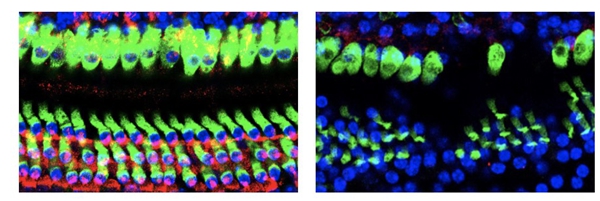
As the global population ages, age-related hearing loss has emerged as a major public health issue. This irreversible decline in hearing not only impacts auditory function but also leads to social isolation, cognitive decline, and a higher risk of Alzheimer's disease. While cochlear aging is the primary cause, our understanding of its molecular regulation is limited due to the reliance on rodent models with different cochlear structures and the lack of human cochlear samples, which reduces clinical relevance.
To address this issue, a collaborative research team led by scientists from the Institute of Zoology of the Chinese Academy of Sciences, Southeast University, and Xuanwu Hospital Capital Medical University has presented the first cellular and molecular map of primate cochlear aging, published in Nature Aging.
This study identifies the downregulation of the hair cell transmembrane transporter SLC35F1 as a core molecular hallmark of cochlear aging. It also demonstrates the protective effects of metformin, a drug traditionally used for type 2 diabetes, on cochlear health. This work bridges the gap from mechanistic discoveries to clinically translatable intervention strategies, offering new therapeutic targets for age-related hearing loss.
The researchers employed a multidimensional analysis approach to elucidate the key biological features of cochlear aging. Through detailed staining and phenotypic characterization at the tissue level, they revealed core pathological changes, including hair cell loss, accelerated aging of spiral ganglion neurons, exacerbated inflammatory damage, stria vascularis atrophy, and impaired transmembrane transport function.
At the cellular and molecular levels, the team combined single-nucleus RNA sequencing with artificial intelligence to create the first high-throughput, high-precision molecular map of primate cochlear aging. This map captured rare subpopulations of hair cells and spiral ganglion neurons, revealing significant age-related transcriptional disruptions, with the specific downregulation of SLC35F1 in hair cells identified as a key molecular signature.
To explore the role of SLC35F1 further, the researchers knocked down SLC35F1 in hair cell lines, which led to significant apoptosis, suggesting that silencing this gene accelerates hair cell loss. Using AAV vector delivery technology, they specifically knocked down SLC35F1 in mouse hair cells, replicating key pathological features of age-related hearing loss, including the accumulation of aging markers, disordered hair cell cilia, hair cell loss, and a decline in hearing function. These findings confirmed SLC35F1's crucial role in maintaining hair cell homeostasis and provided new molecular insights into the pathogenesis of age-related hearing loss.
Building on previous research demonstrating metformin's anti-aging effects in elderly primates, the team investigated its protective effects on aged primate cochleae. After 3.3 years of treatment, elderly cynomolgus monkeys receiving clinical doses of metformin exhibited significant cochlear rejuvenation: reduced hair cell loss, decreased atrophy of the stria vascularis, and a lower proportion of aging spiral ganglion neurons. Transcriptomic analysis revealed that metformin's protective effects were due to dual mechanisms: downregulating inflammation-related genes and upregulating key genes involved in sound perception and neural signaling.
This study is the first to systematically delineate the cellular and molecular trajectories of primate cochlear aging, revealing key susceptible cell types and their specific aging drivers, such as SLC35F1, while confirming metformin's significant anti-aging effects in primate models.

Hair cell loss and reduced SLC35F1 expression in aged cynomolgus monkeys: Young group (left), Aged group (right). (Image by LIU Guanghui's lab)

86-10-68597521 (day)
86-10-68597289 (night)

52 Sanlihe Rd., Xicheng District,
Beijing, China (100864)

